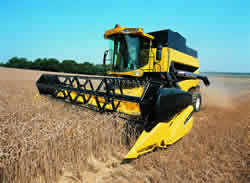
New Holland has extended its already comprehensive combine harvester offering with the addition of two new models to its CS range.
The existing CS540 and CS640 have, in a single year, already carved a significant place for themselves, appealing in particular to those growers and contractors looking for a sound investment in a workmanlike yet up-to-the-minute machine.
This appeal now broadens with the addition of the five- and six-straw walker CS520 and CS660.
The CS520 offers ¡¥entry-level¡¦ access to the prestigious and distinctive new ¡¥family¡¦ styling, first seen on the CX range, while the 281hp top-of-the-range CS660, with its 8800-litre grain tank capacity, will attract contractors and larger-scale growers.
Supreme comfort, style and capacity are the watchwords for the entire CS range. But probably its most distinguishing hallmark is its ability to preserve the very best-quality straw without compromising output, regardless of crop condition.
¡§With the gap closing between the value of straw and the value of grain per hectare in a number of situations, and new markets emerging for straw, having good ¡¥baleable¡¦ quality is becoming increasingly important,¡¨ says product marketing manager, Nigel Mackenzie.
It is the CS¡¦ unique patented Opti-ThreshTM system, which allows the rear 36o-section of the 121o-wrap concave to be folded away from the drum, that is responsible for this particular aspect of the combine¡¦s performance.
The raise/lower adjustment is made using a simple side-mounted, two-position lever.
Multi-ThreshTM concave position adjustment on the rotary separator ƒ{ which is optional on the existing models, but standard on the CS660 ƒ{ complements the thorough but gentle crop treatment.
¡§In summary, the combination of features on the CS allows users to set a precise balance between capacity and straw-friendliness, under a broad range of harvesting conditions and for the widest variety of crops,¡¨ says Mr Mackenzie.
Continuing the straw theme to the back of the machine, all CS combines can be equipped with the standard straw hood canvas, or optional straw chopper.
¡§In addition, the top three models can be specified with an independent chaff spreader which then allows chaff to be either spread or directed into the straw flow when swathing,¡¨ says Mr Mackenzie.
¡§Where straw is to be incorporated, again there is the option to spread chaff independently or in the main stream of chopped straw, where it will travel further, especially in side winds.¡¨
As for the header, cleaning ability, unloading rate, the drivelines and the cab, the CS can be described as ¡¥best in class¡¦ in each case.
In particular, a simple but heavy-duty drum drive, a new cascade pre-cleaning system that provides a dual air blast, and Tier II-compliant engines all contribute to an excellent all-round performance.
Automatic header compensation and stubble height control are standard on the CX-spec headers, with lateral float optional on the five-straw walker machines and Autofloat an option on all CS models.
Visibility onto the header from the quiet and comfortable Discovery Plus cab is excellent, thanks not least to the length of the straw elevator.
At the same time, the mounting position of the slim monitor on the right-hand side A-pillar gives the operator at-a-glance eye-level information on all the important engine, threshing and cleaning functions.
A multi-function control lever with large ¡¥easy-feel¡¦ buttons and in-line gear shift further ease the burden on the operator.
Vital functions are engaged through electro-pneumatic or hydraulic components ƒ{ the use of electronics being reserved for monitoring purposes only.
Not only does this avoid the complexity of electro-hydraulics, but a pneumatic clutch and actuators also provide very smooth engagement of header, threshing, chopper and unloading system.
A standard air compressor not only provides air pressure for the remote controls, but is also invaluable for cleaning the machine away from the yard, particularly when moving between seed crops or trying to reduce contamination by weed seeds.
Practical considerations such as this, together with economical operation and technological advances define the CS combine¡¦s special ability to optimise performance and quality of output.
